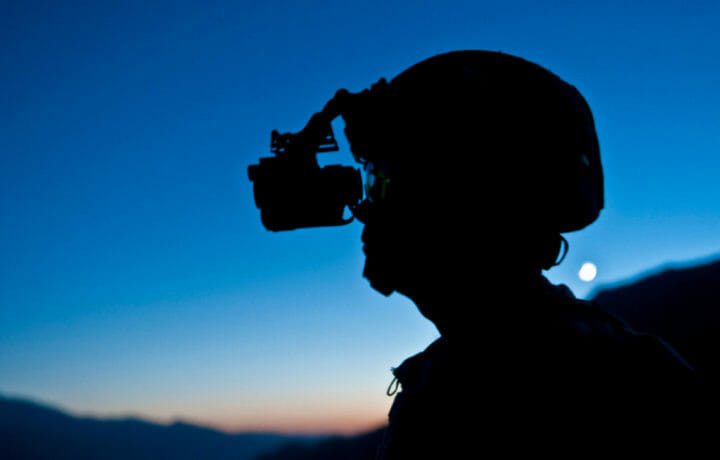The Defense Advanced Research Projects Agency (DARPA) is the research and development branch of the United States Department of Defense that creates the high-tech gizmos and gadgets that help provide our warfighters with an edge on the battlefield. DARPA is the agency that makes what might seem like science fiction very much a reality, and this month it announced it won’t leave soldiers or pilots in the dark. DARPA has been working to develop a revolutionary new type of night-vision technology that could provide goggles that are just the size and weight of regular eyeglasses.
Early Night Vision
Attempts to develop night-vision technology can be traced back to the Second World War, and there have been numerous efforts to improve the system that allows soldiers to see in the dark. The technology took a major leap during the Vietnam War, when the first system to utilize ambient light instead of an extra infrared light source. It still needed moonlight to function properly.
More recent efforts have sought to combine thermal imaging with image intensification, but even today night-vision goggle systems are bulky as they require cumbersome binocular-like optics mounted to a helmet. In addition, these systems limit the field of view (FOV) while the weight puts a strain on the user’s neck.
Yet, like most electrics the issue of size is being addressed, as is the functionality.
In November, Elbit Systems of America was awarded an Other Transaction Authority (OTA) contract from the U.S. Army for Enhanced Night Vision Goggle – Bionular (ENVG-B) system. The new system will provide U.S. warfighters with improved situational awareness during limited visibility conditions, while increasing their lethality through faster target acquisition. The ENVG-B system will now undergo various qualification phases.
DARPA’s Latest Improvements
This month DARPA announced its enhanced Night Vision in eyeglass form (ENVision) program, which has the aim to create lightweight NVGs that offer a wide FOV across multiple infrared (IR) spectrum bands without needing separate optics for each IR band. According to DARPA, the goal of the project is to allow warfighters and other military personnel the ability to have night vision through fog, dust, and other obscurants as well as provide thermal vision. Instead of the large NVGs currently used with helmets, this new platform could all be contained via a single flat lens.
DARPA announced that a Proposers Day for interested participants will be held via webinar on January 21.
“Our warfighters experience significant neck strain from current NVGs caused by the weight of the optics extending four to five inches in front of their helmets,” explained Rohith Chandrasekar, program manager in DARPA’s Defense Sciences Office via the official DARPA website.
“If you’ve never worn NVGs for hours at a time imagine wearing a baseball cap all day with a two-pound weight attached to the front of the bill – that gives you a small sense of the stress experienced,” added Chandrasekar. “Extended use of such systems leads to a condition where the neck no longer has energy to keep the head upright requiring warfighters to use their hands to lift and point their heads. NVG wearers also have to swivel their heads frequently for peripheral vision since current optics only provide a 40-degree field of view compared to the 120-degree wide view we have with our eyes, which only makes use of NVG systems more painful.”
Improved IR
In addition to addressing the issue of weight and field-of-view constraints, current NVGs also only provide a narrow segment of the IR portion of the spectrum, typically near-IR. As a result that can limit the threats that wearer’s of such systems can see at night, and while it is an improvement over no night-vision, DARPA is working to enhance what users see.
The goal is to expand the FOV and IR bandwith while also decreasing the weight.
“DARPA investments over the past decade have led to breakthroughs in the areas of planar optics, detection materials, and novel light-matter interactions,” Chandrasekar noted. “ENVision will leverage these advancements, amongst others, to develop enhanced night-vision devices in lightweight eyeglass form factors.”
New Way to Look at the Problem
Addressing the challenges has required DARPA to look towards using thin materials that can directly convert photons from the infrared to the visible band of the spectrum rather than using a vision processing system. By taking that route, it will help solve the bulk and weight issues.
“This will further simplify NVG systems by advancing from the multi-step conversion currently used to a single step up-conversion process,” Chandrasekar said. “Some of these processes even conserve the momentum of photons, which, in theory, could enable night vision without the need for any optics.”



